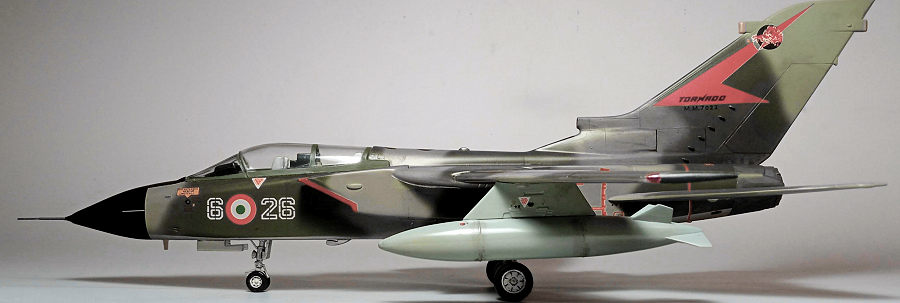
Heller 1/48 Tornado IDS
| KIT #: | 80430 |
| PRICE: | $30.00 in 2005 |
| DECALS: | Two options |
| REVIEWER: | Spiros Pendedekas |
| NOTES: |
Reboxed Airfix Kit |

| HISTORY |
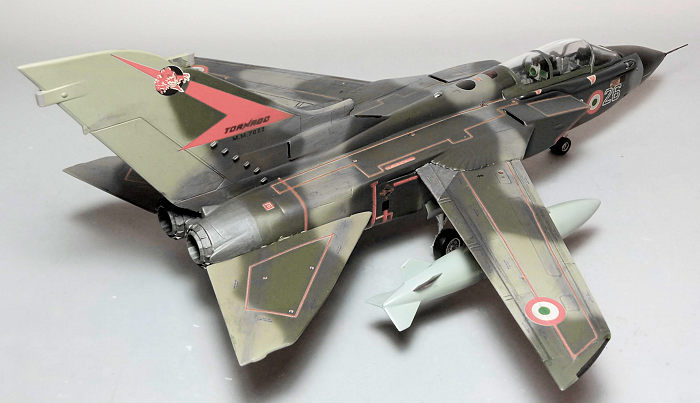 The Panavia
Tornado was primarily designed for high-speed/low-level penetration, targeting
the invading forces of the Eastern Europe Warsaw Pact countries. To achieve
this, but still be able to have good low-speed flight characteristics,
variable-wing geometry was utilized, which, by the time of the Tornado design
(late 60s to early 70s) was among the most preferred configurations. The twin
engine layout with thrust reversers to reduce landing distance, the handy
fly-by-wire system, which made the aircraft easier to fly and the advanced for
the time avionics only added to the value of this efficient strike aircraft.
The Panavia
Tornado was primarily designed for high-speed/low-level penetration, targeting
the invading forces of the Eastern Europe Warsaw Pact countries. To achieve
this, but still be able to have good low-speed flight characteristics,
variable-wing geometry was utilized, which, by the time of the Tornado design
(late 60s to early 70s) was among the most preferred configurations. The twin
engine layout with thrust reversers to reduce landing distance, the handy
fly-by-wire system, which made the aircraft easier to fly and the advanced for
the time avionics only added to the value of this efficient strike aircraft.
Apart from strike, the type's true capability to undertake various roles (reconnaissance, maritime patrol and electronic countermeasures) with minimal to modest modifications (something not too easily achieved in practice, especially for the times) enabled various operators to implement it as a common type. Through life extension and upgrading programmes, the successful Tornado will remain in service until at least 2025, spanning an awesome operational career of almost 50 years!
The Aeronautica Militare received 100 Tornado IDS (Interdictor Strike - known as the A-200 in Italian service), with 16 of them subsequently converted to the ECR (Electronic Combat Reconnaissance) configuration. Additionally, 24 RAF Tornado ADV (Air Defense Variant) were leased for 10 years to the Aeronautica Militare to fill the gap in the air defense role between the retirement of the F-104 Starfighter and the introduction of the Eurofighter Typhoon.
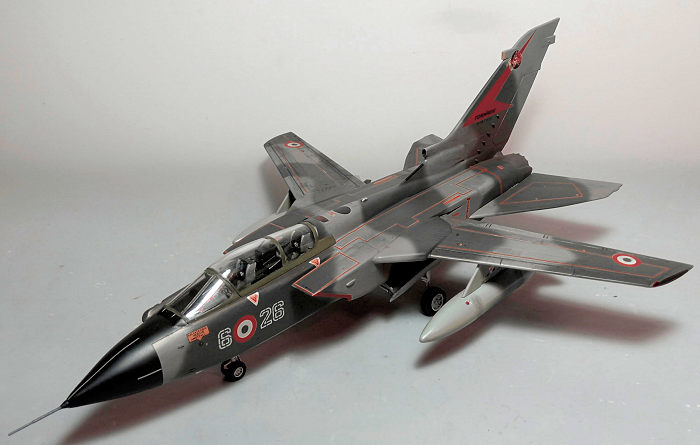 Italian
Tornados, along with RAF Tornados, took part in the first Gulf War in 1991, with
one aircraft lost to Iraqi anti-aircraft fire, the pilots ejecting safely but
captured by Iraqi forces. 22 Italian Tornados were deployed over Kosovo in 1999.
Four examples are also reported to have been dispatched to the Afghanistan
region in 2010. In 2011, Italian Tornados participated in the enforcement of a
UN no-fly zone during the military intervention in Libya, launching, among
others, a good number of Storm Shadow cruise missiles. By the end of 2014, it
was announced that four machines would be sent to Kuwait, taking part in
coalition operations against the Islamic State in the reconnaissance role.
Italian
Tornados, along with RAF Tornados, took part in the first Gulf War in 1991, with
one aircraft lost to Iraqi anti-aircraft fire, the pilots ejecting safely but
captured by Iraqi forces. 22 Italian Tornados were deployed over Kosovo in 1999.
Four examples are also reported to have been dispatched to the Afghanistan
region in 2010. In 2011, Italian Tornados participated in the enforcement of a
UN no-fly zone during the military intervention in Libya, launching, among
others, a good number of Storm Shadow cruise missiles. By the end of 2014, it
was announced that four machines would be sent to Kuwait, taking part in
coalition operations against the Islamic State in the reconnaissance role.
The 6º Stormo, known as the "Diavoli Rossi", based at Ghedi airport near Brescia, is an interdiction unit of the Aeronautica Militare operating the Tornado and, from 16 June 2022 onwards, gradually transforming to the F-35. Named in memory of pilot Lieutenant Alfredo Fusco, it was formed at the Campoformido airport, near Udine, on 15 January 1936 and fought both in the Mediterranean and North Africa Theaters during WWII. Post war, the famous Stormo had, among others, undertaken the “Strike” role (attacking with nuclear weapons certain Warsaw Pact targets), currently proudly transforming to the 5th generation fighters.
| THE KIT |
This is the venerable Airfix mold, first introduced in 1987 and reissued till 2005. A good kit for the times, with correct general shape but softer on the details compared to the more modern offerings of Revell and Hobby Boss, can still be built to a decent representation of the iconic Tornado. The specific kit is the 1994 Heller rebox (by those times Heller and Airfix were the same company) and for a look at its contents you may read our Editor’s preview of the essentially identical (apart from markings) Airfix 1992 kit, found at the MM archives.
| CONSTRUCTION |
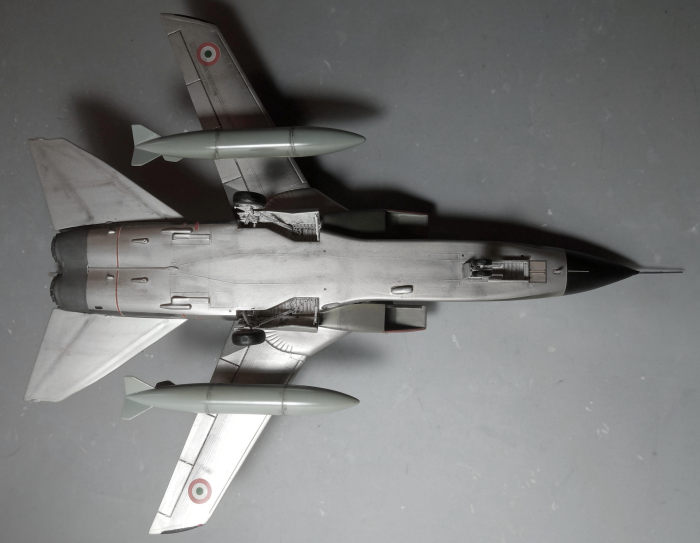 Opting for a
totally out of the box (OOB) build, first thing I did was to put together the
cockpit, consisting of the cockpit tub, instrument panels, control sticks and
seats, with the completed cockpit attached to the upper fuselage half from the
undersides. Basic cockpit color was Hu147 Light Gray with black top anti glare
areas and stick grips. All instruments, including side consoles, were
represented with decals, with a tiny blob of green clear paint representing the
navigator’s radar screen. Seats had light gray framing and linen, light olive
and black lower, rear and head cushions respectively. I decided not to use the
relatively nice looking pilots, which, especially for my OOB build, was rather a
mistake, as the lack of pilots made the cockpit sparseness more evident,
especially that of the seats, even under the closed canopy.
Opting for a
totally out of the box (OOB) build, first thing I did was to put together the
cockpit, consisting of the cockpit tub, instrument panels, control sticks and
seats, with the completed cockpit attached to the upper fuselage half from the
undersides. Basic cockpit color was Hu147 Light Gray with black top anti glare
areas and stick grips. All instruments, including side consoles, were
represented with decals, with a tiny blob of green clear paint representing the
navigator’s radar screen. Seats had light gray framing and linen, light olive
and black lower, rear and head cushions respectively. I decided not to use the
relatively nice looking pilots, which, especially for my OOB build, was rather a
mistake, as the lack of pilots made the cockpit sparseness more evident,
especially that of the seats, even under the closed canopy.
The nose bay was attached to the lower fuselage. The wings and tail planes were
next assembled, each of them being a 2-piece affair and then trapped between the
fuselage halves. Though the kit is designed so that both the wings and the
all-moving tail planes are moveable, I decided to permanently attach all of
them, fearing that they would exhibit slack and/or sag over time. Instructions
called for 15 grams of nose weight to avoid tail sitting, I added 30 grams just
to be sure. I elected to pose the wings “extended”, as I like the posture more,
the only ‘drawback” being the void looks of the “sealing pneumatic curtain” wing
root area.
The intakes were next assembled and attached, their innards painted light gray,
followed by the fin and air brakes, which were attached “retracted”. The
refueling probe was finally assembled and attached, also in “retracted”
position, together with a few filets and small air intakes, the latter drilled
out for extra realism.
This concluded basic assembly, which was relatively uncomplex for a modern jet,
with overall fit being acceptable, needing its usual attention at the “usual”
places (such as the intakes, fin and top/bottom fuselage joints). After some
filling and sanding, I blanked the cockpit and air intakes with wet tissue and
took the imposing bird to the paint shop!
| COLORS & MARKINGS |
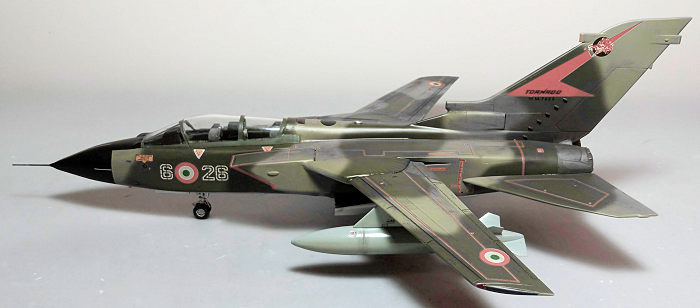 I wanted to
depict a "Diavoli Rossi" Tornado, at its earlier scheme, which was one of the
two kit decal options. These past Aeronautica Militare schemes were quite
interesting and very charming, consisting of dark green/gray topsides over
aluminum undersides.
I wanted to
depict a "Diavoli Rossi" Tornado, at its earlier scheme, which was one of the
two kit decal options. These past Aeronautica Militare schemes were quite
interesting and very charming, consisting of dark green/gray topsides over
aluminum undersides.
I first gave the nose radome, front anti glare and a few dielectric areas at the
wing tips and fin a coat of Hu33 black. After masking it off, I gave all
undersides, including gear doors, a coat of Hu11 silver, which was also masked
off. The topside green/gray camo was freehanded using Hu91 Black Green and Hu64
Light Gray respectively. No shade accuracy whatsoever is claimed for the chosen
colors, in fact, should I do it again, I would at least go for a more "bluish"
gray shade, and, possibly, a slightly lighter green one. Upon removing all
masks, I gave the bird a coat of Future to prepare it for decaling.
I used the kit decals, which were well printed (not always the case for the
older Heller/Airfix decals) and, though old, looked in good condition. To my
satisfaction, they behaved reasonably well, easily detaching from their backing
paper and solidly adhering to the model surfaces, with the comprehensive
stenciling adding a lot to the final looks. A coat of Future sealed all decals.
| FINAL CONSTRUCTION |
It was time to attach
the well molded but fragile looking one piece gear legs in position, followed by
the wheels and doors, with the bird proudly standing on its feet. Legs, wheel
rims, bays and door innards were painted white, oleos and the front mounted
landing/taxi light were highlighted with a fine tip silver pen and tires were
black. The wheels were tad filed to look weighted.
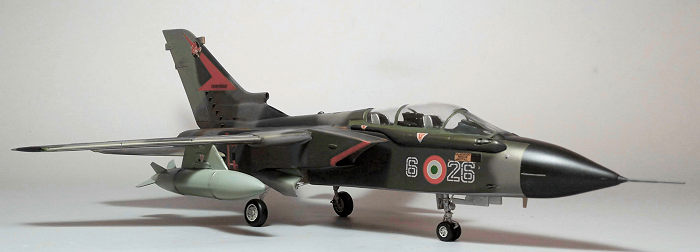 The wing
tanks were assembled and attached in place. To add some flavor, I went for an
all-gray, rather glossy color for the wing tanks, assuming they were from a
later batch, painted likewise. No other ordnance was attached, which, in
retrospect, was not a good choice, as the Tornado would certainly look meaner -
I should at least have added the twin fuselage and outer wing pylons. The good
looking exhaust nozzles were finally painted Testors Burned Metal and attached
as well.
The wing
tanks were assembled and attached in place. To add some flavor, I went for an
all-gray, rather glossy color for the wing tanks, assuming they were from a
later batch, painted likewise. No other ordnance was attached, which, in
retrospect, was not a good choice, as the Tornado would certainly look meaner -
I should at least have added the twin fuselage and outer wing pylons. The good
looking exhaust nozzles were finally painted Testors Burned Metal and attached
as well.
Time for some weathering, which consisted of a black wash to all landing gear
bits, bays, door innards and all recessed hinges, to offer an oily, more real
look, followed by application of dark brown and dark dry pastels to simulate
dirt, grime and engine soot, the latter being clearly evident as it gradually
builds up at the lower fin areas of all Tornados due use of the thrust
reversers. A satin coat gave the bird its final hue.
The windscreen and canopy had their well defined frames hand painted and
attached in position, where my lifetime habit of hand painting canopies was not
too rewarding this time, as the shade of green, though coming from the same
bottle, came notably different, despite my remedial attempts (coating with
Future and final satin shade).
The pitot was painted gunmetal and attached in position. The dorsal beacon was
carefully highlighted with my fine tip silver pen. Blobs of red and green clear
paint represented the wingtip lights, before calling the iconic bird done!
| CONCLUSIONS |
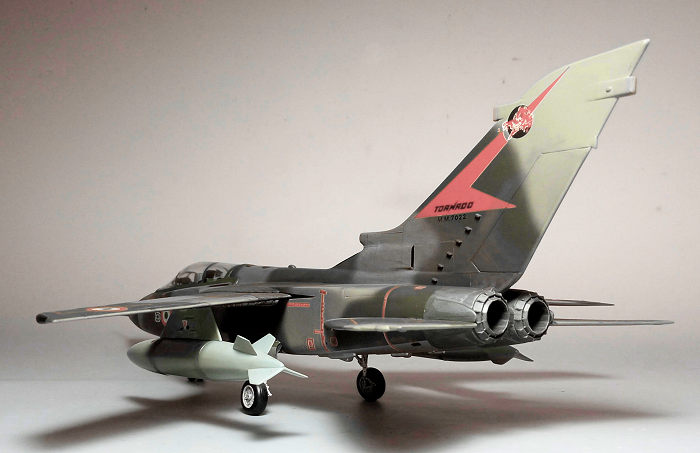 Though
getting elderly and definitely superseded by the modern offerings of Hobby Boss
and Revell in all areas but complexity of build, this Heller/Airfix mold is
still a decent kit of the famed plane. General shape looks correct, molding is
good as was overall fit, the level of detail is acceptable and decals were
comprehensive.
Though
getting elderly and definitely superseded by the modern offerings of Hobby Boss
and Revell in all areas but complexity of build, this Heller/Airfix mold is
still a decent kit of the famed plane. General shape looks correct, molding is
good as was overall fit, the level of detail is acceptable and decals were
comprehensive.
Out of the box, a good representation of the Tornado can emerge, with the
relatively uncomplex construction deeming the kit suitable even for less
experienced modelers. A good amount of nice aftermarket is available, should you
wish to beef up the kit looks (I would definitely go for some cockpit
enhancement bits and resin Mk.10 seats). So, if you have one or find one at a
good price, go on and build it! A nice Tornado will emerge.
Happy Modeling!
23 January 2024 Copyright ModelingMadness.com. All rights reserved. No
reproduction in part or in whole without express permission. If you would like your product reviewed fairly and fairly quickly, please
contact the editor or see other details in the
Note to
Contributors.